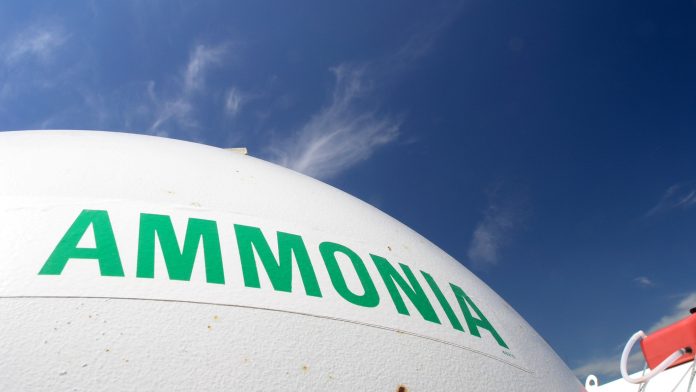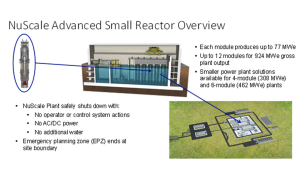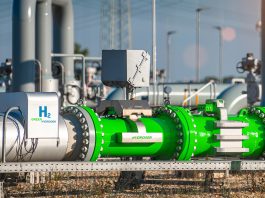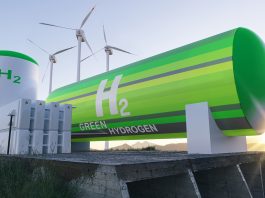Powered by small modular reactors from NuScale Power, the US university and national lab team is set to revolutionise the carbon-intensive industry with green ammonia production.
Hydrogen, a promising energy carrier and an important feedstock for many industries, has been widely recognised as a game-changer in long-term energy and environmental sustainability.
However, most hydrogen is currently produced using natural gas via the steam reforming process, emitting about 9.4kg CO2 per kilogramme of H2 produced. This leads to a wells-to-gate greenhouse gas emission of more than 10kg CO2 per kilogramme of H2.
With 43% of hydrogen production used for ammonia production in 2018,1 ammonia production alone accounts for 2% of overall fossil energy use and 1.2% of total GHG emissions.2, 3
In order to help the transition to sustainable energy, green (carbon-free) hydrogen through electrolysis of water is critical. While wind and solar are desirable energy sources for electrolysers, their intermittent nature requires extensive and costly energy storage.
The potential of SMRs for green ammonia production
With the recent advancements in modularity, simplicity and factory assembly, small modular reactors (SMR) possess the unique advantage of providing steady and low-cost hydrogen onsite, reducing or even eliminating the costly energy storage and H2 transportation needed for various industrial applications.
Given that the electricity required for the electrolysis process dominates the hydrogen production cost,4 using an SMR as the primary energy source to supply electricity and steam to high-temperature electrolysers (HTE) can further reduce the production cost of carbon-free hydrogen.
Recent estimates indicate that a commercial scale H2 production rate of 250-300 metric tons/day can be achieved economically with a six NuScale Power Module (VOYGRTM-6 plant).
Thus, integrating onsite hydrogen generation powered by an SMR with industrial processes can eliminate the significant costs associated with hydrogen production and transportation, creating a potentially viable solution for low-cost carbon-free hydrogen production, as well as its downstream products.
Decarbonising ammonia
With 80% of the ammonia produced today being used in fertilisers such as urea and ammonium nitrate, a significant increase in ammonia production is expected with population growth, according to historical data.5 Thus, decarbonising the existing ammonia market represents a large opportunity for carbon-free ammonia to significantly reduce global GHG emissions.
Leveraging its simplicity and cost advantages, SMRs are in the position to help the energy-intensive ammonia production industry reduce carbon emissions.
Moreover, ammonia is increasingly considered an energy vector. In terms of the cost of storage and transportation, ammonia has significant advantages over hydrogen.6 Thus, we expect carbon-free ammonia will play a key role in enabling carbon-free hydrogen.
The solution: Collaboration and innovation
Funded by the U.S. Department of Energy under the Nuclear Energy University Program (NEUP), this project will develop two reference designs of carbon-free (green) ammonia plants. One design uses freshwater as the source of hydrogen, while the other design uses seawater (or brackish water) as the source.
Innovative freeze desalination is expected to play an essential role in deploying the technology. In both designs, a high-temperature steam electrolyser currently under intense development and testing will be modelled, and the NuScale SMR will be used as the primary energy source, providing both electricity and steam for the plants. An overview of NuScale’s advanced SMR is shown here.
This project is led by Dr Hailei Wang from Utah State University. He and his group will lead process modelling, system integration, and reference design efforts. Most of the proposed work will be conducted in his Energy Technology Research and Innovation (eTRI) lab.
The lab has well-established integrated energy system modelling and optimisation capabilities, thermal-hydraulic modelling and experimental facilities. His group will work closely with scientists and engineers from Idaho National Lab (INL), Argonne National Lab (ANL) and NuScale Power.
INL is the U.S. Department of Energy Office of Nuclear Energy’s lead laboratory. It has a strong research programme on small modular reactors (SMRs). INL will support the university team’s process modelling, design and techno-economic analysis (TEA) of the high-temperature electrolyser.
ANL is a U.S. Department of Energy multidisciplinary science and engineering research centre. It is a national leader in energy systems assessment, process modelling and technoeconomic analysis for the production of electro-fuels or electro-chemicals. ANL will support the university team on ammonia process modelling and its TEA.
In addition, the project will also benefit from NuScale Power’s active involvement and industry perspectives.
An opportunity for SMR-powered green ammonia production
In summary, this project provides an opportunity to demonstrate examples of SMR-powered integrated energy systems (IES) for carbon-free ammonia production.
Having all feedstocks, such as hydrogen and nitrogen, produced onsite (co-located) provides great opportunities for system integration and efficiency improvement, leading to potentially greater cost reduction.
If successful, the proposed reference designs of carbon-free (green) ammonia can be built essentially everywhere, opening up the opportunity to bring ammonia plants close to the point of their consumption, significantly reducing the costs and carbon emissions associated with transportation.
Given that ammonia is also being considered as a potential fuel candidate for marine-time ships,7,8 the proposed Reference Design 2 can be located near seawater to serve marine customers. In return, producing carbon-free ammonia beyond carbon-free hydrogen will greatly diversify the applications for SMRs in a clean energy economy.
References
- “Global demand for pure hydrogen, 1975-2018 – Charts – Data & Statistics,” IEA. Accessed: Sep. 17, 2022. [Online]. Available: https://www.iea.org/data-and-statistics/charts/global-demand-for-pure-hydrogen-1975-2018
- S. Giddey, S. P. S. Badwal, C. Munnings, and M. Dolan, “Ammonia as a Renewable Energy Transportation Media,” ACS Sustainable Chem. Eng., vol. 5, no. 11, pp. 10231–10239, Nov. 2017, doi: 10.1021/acssuschemeng.7b02219.
- X. Liu, A. Elgowainy, and M. Wang, “Life cycle energy use and greenhouse gas emissions of ammonia production from renewable resources and industrial by-products,” Green Chem., vol. 22, no. 17, pp. 5751–5761, Aug. 2020, doi: 10.1039/D0GC02301A.
- “20004-cost-electrolytic-hydrogen-production.pdf.” Accessed: Sep. 19, 2021. [Online]. Available: https://www.hydrogen.energy.gov/pdfs/20004-cost-electrolytic-hydrogen-production.pdf
- S. A. Nosherwani and R. C. Neto, “Techno-economic assessment of commercial ammonia synthesis methods in coastal areas of Germany,” Journal of Energy Storage, vol. 34, p. 102201, Feb. 2021, doi: 10.1016/j.est.2020.102201.
- “20211122_WP_eAmmonia.pdf.”
- “Ammonia as a shipping fuel.” Accessed: Oct. 04, 2022. [Online]. Available: https://www.globalmaritimeforum.org/news/ammonia-as-a-shipping-fuel
- K. Machaj et al., “Ammonia as a potential marine fuel: A review,” Energy Strategy Reviews, vol. 44, p. 100926, Nov. 2022, doi: 10.1016/j.esr.2022.100926.
- “Hydrogen Shot,” Energy.gov. Accessed: Oct. 04, 2022. [Online]. Available: https://www.energy.gov/eere/fuelcells/hydrogen-shot
Please note, this article will also appear in the 18th edition of our quarterly publication.










